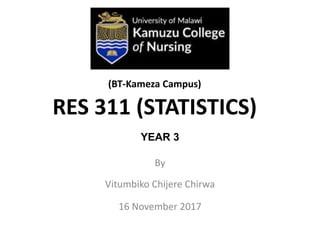
Probability.pptx
- 1. YEAR 3 By Vitumbiko Chijere Chirwa 16 November 2017 RES 311 (STATISTICS) (BT-Kameza Campus)
- 2. PROBABILITY
- 3. Probability • We live in a world full of uncertainties... • Researchers use probability to establish confidence in their findings. The reason why researchers are concerned with establishing confidence in their findings is a consequence of their using data that are collected from samples. • Because we make generalizations from samples to infer about the population, there is always a chance to commit errors • Researchers try to establish confidence by talking about their findings with regard to probability
- 5. Basic laws (axioms) of probability • The probability that an event will CERTAINLY NOT occur: P(E) = 0 (examples?) • The probability that an event will CERTAINLY occur: P(E) = 1 • The probability of any event is ALWAYS between (and can include) 0 and 1: 𝟎 ≤ 𝑷 𝑬 ≤ 𝟏 • The sum of all probabilities of all simple events in a sample space = 1
- 7. Rule of Complementary events • Definition: A complement of an event E is the set of all outcomes in the sample space that are not included in the outcome(s) of E • Denoted as 𝑬𝒄 𝑜𝑟 𝑬′ 𝑜𝑟 𝑬 E 𝑬𝒄
- 8. Rule of Complementary events • The outcomes of an event and the outcomes of the complement make up the entire sample space • Therefore: 𝑃 𝐸 + 𝑃 𝐸𝑐 = 1 • 𝑃 𝐸 = 1 − 𝑃 𝐸𝑐 and 𝑃 𝐸𝑐 = 1 − 𝑃 𝐸 E 𝑬𝒄
- 9. Example What is the probability that a randomly chosen person cannot donate blood to everyone of any blood type?
- 10. Rules of Compound events • Definition: a compound event is a combination of two or more events a) Union of events: the union of two events A and B is the set of outcomes that are included in A or B or both A and B b) Intersection of events: the intersection of two events A and B is the set of outcomes that are included in both A and B
- 11. Rules of Compound events a) Union of events: 𝐴 ∪ 𝐵 𝑷 𝑨 𝒐𝒓 𝑩 = 𝑷 𝑨 + 𝑷 𝑩 − 𝑷 𝑨 𝒂𝒏𝒅 𝑩 𝑷 𝑨 ∪ 𝑩 = 𝑷 𝑨 + 𝑷 𝑩 − 𝑷 𝑨 ∩ 𝑩 b) For mutually exclusive events: P 𝐴 ∩ 𝐵 = 0 𝑷 𝑨 ∪ 𝑩 = 𝑷 𝑨 + 𝑷 𝑩 − 𝑷 𝑨 ∩ 𝑩 A B
- 12. Example What is the probability that a randomly chosen person is a potential donor for a person with blood type A?
- 13. Conditional probability • This is a probability of an event A given that an event B has already occurred a) P(A given B): is denoted as P(A/B) P(A/B) = 𝑃(𝐴∩𝐵) 𝑃(𝐵) where P(B) ≠ 0 b) P(B given A): is denoted as P(B/A) P(B/A) = 𝑃(𝐴∩𝐵) 𝑃(𝐴) where P(A) ≠ 0
- 14. Independence in probability • Two (or more) events are said to be independent if the occurrence of one event DOES NOT INFLUENCE the occurrence of the other a) P(A given B): is just P(A) b) P(B given A): is just P(B) Therefore: 𝑷 𝑨 ∩ 𝑩 = 𝑷 𝑨 × 𝑷 𝑩 , and 𝑷 𝑨 ∪ 𝑩 = 𝑷 𝑨 + 𝑷 𝑩 − 𝑷 𝑨 × 𝑷(𝑩)
- 15. Example • A cross-tabulation table was used from a study of emergency department (ED) services for sexual assault victims in Virginia (Table on following slide) (Plichta, Vandecar-Burdin, Odor, Reams, and Zhang, 2007). This study examined the question: Does having a forensic nurse trained to assist victims of sexual violence on staff in an ED affect the probability that a hospital will have a relationship with a rape crisis centre? Some experts thought that having a forensic nurse on staff might actually reduce the chance that an ED would have a connection with a rape crisis centre. The two variables of interest here are “forensic nurse on staff ” (yes/no) and “relationship with rape crisis centre” (yes/no). A total of 53 EDs provided appropriate responses to these two questions.
- 16. Find the probability: a) that the ED will have a forensic nurse on staff b) of not having a forensic nurse on staff c) that the ED will have a relationship with a rape crisis center d) that the ED will not have a relationship with a rape crisis center e) (relationship with rape crisis center|no forensic nurse) f) (relationship with rape crisis center|forensic nurse)
- 17. Example • Consider randomly selecting one individual from those represented in the following table regarding the periodontal status of individuals and their gender. Periodontal status refers to gum disease where individuals are classified as either healthy, have gingivitis, or have periodontal disease.
- 18. Find: a) P(Male) b)P(Female) c) P(Healthy) d)P(Not Healthy) e) P(Male and Healthy) f) P(Male or Healthy)
- 19. Example • A doctor gives a patient a 60% chance of surviving bypass surgery after a heart attack. If the patient survives the surgery, he has a 70% chance that the heart damage will heal. Find the probability that the patient survives surgery and the heart damage does not heal.